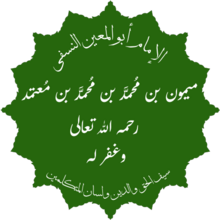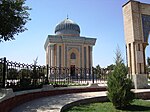Abu al-Mu'in al-Nasafi
You can help expand this article with text translated from the corresponding article in Arabic. (April 2019) Click [show] for important translation instructions.
|
Abu al-Mu'in al-Nasafi أبو المعين النسفي | |
|---|---|
 Abu al-Mu'in al-Nasafi's name in Arabic calligraphy | |
| Title | His Bahr al-Kalam has had considerable popularity, and on the title-page of the printed edition he is called: "Chief of the People of al-Sunna and al-Jama'a, Sword of the truth and of religion".[1] |
| Personal | |
| Born | 418 A.H. = 1027 A.D. 438 A.H. = 1046 A.D. |
| Died | 508 A.H. = 1114-5 A.D. |
| Religion | Islam |
| Era | Islamic Golden Age |
| Region | |
| Denomination | Sunni |
| Jurisprudence | Hanafi |
| Creed | Maturidi |
| Main interest(s) | Aqidah, Kalam (Islamic theology), Fiqh (Islamic jurisprudence), Semantics |
| Notable work(s) | Tabsirat al-Adillah, Bahr al-Kalam |
| Muslim leader | |
Influenced by | |
Abu al-Mu'in al-Nasafi (Uzbek: Абул-Муин ан-Насафи; Arabic: أبو المعين النسفي), was considered to be the most important Central Asian Hanafi theologian in the Maturidite school of Sunni Islam after Imam Abu Mansur al-Maturidi (d. 333 A.H), provided a fairly detailed account of al-Maturidi Central Asian predecessors.[2][3][4][5]
Name
His name was Abu al-Ma'in Maymun b. Muhammad b. Muhammad b. Mu'tamad b. Muhammad Ibn Mak-hul b. al-Fadhl al-Nasafi al-Mak-huli.[6]
Birth
He was born in Nasaf (present Karshi) around 438 A.H. (1046 A.D.) and died in the same city in 508 A.H. (1115 A.D.).[7] It was said that his birth was in 418 A.H. (1027 A.D.) according to Khair al-Din al-Zarkali and Umar Rizo Kahhol, while Qutluwbugha says it was in 438 A.H. (1046 A.D.), based on the age of his death being seventy years in the year of 508 A.H. (1115 A.D.).[8]
Life
Classical sources give no information about his life, but he lived in an age in which Muslim theology was reaching its peak, and he contributed to this development.
He was born in an educated family. His ancestors were respected by society as great scholars of "fiqh" science. His great-grandfather, Makhul Nasafi, was a disciple of Imam al-Maturidi, and his grandfather, Mu’tamid ibn Makhul Nasafi, was famous as a theologian, Hanafi jurist (Faqih), and mystic (Sufi) who was reported to have written a number of works.[9] He received his primary education from his father and grandfather.[10]
Kalam
Abu al-Mu'in al-Nasafi was one of the prominent representatives of "kalam", the science of aqeedah, and played an important role in the wide dissemination of the teachings of Maturidiyya, founded by Abu Mansur al-Maturidi.[11][12][13]
Students
Some of his popular students are:[14]
- Najm al-Din 'Umar al-Nasafi (d. 537/1142), the author of al-'Aqa'id al-Nasafiyyah (Arabic: العقائد النسفية).[15]
- 'Ala' al-Din Samarqandi (d. 539/1144), the author of Tuhfat al-Fuqaha' (Arabic: تحفة الفقهاء).[16]
- 'Ala' al-Din al-Kasani (d. 578/1191), the author of Bada'i' al-Sana'i' (Arabic: بدائع الصنائع).
- Sadr al-A'imma Abu al-Ma'ali Ahmad b. Muhammad b. Muhammad b. al-Husain al-Bazdawi (d. 542/1147).
Sometimes it's assumed that Abu al-Thana' al-Lamishi was a student of him, though this is not known for sure.[17]
Books
He wrote many works aimed at clarifying misconceptions about Islam, fighting religious fanaticism.[18] Some of his popular and widely accepted works are as follows:[19][20]
- Tabsirat al-Adillah (Instructing the Evidences); is considered as the second major work in the Maturidi curriculum, after Imam al-Maturidi's Kitab al-Tawhid.
- Al-Tamhid li-Qawa'id al-Tawhid (Introduction to the Principles of Monotheism); is a summary of Tabsirat al-Adilla (Instructing the Evidences).
- Bahr al-Kalam fi 'Ilm al-Tawhid (Ocean of Discussions on the Science of Monotheism); is one of the main sources of "kalam" science in Maturidism.
Death
It has been widely accepted and agreed upon that he died in the year of 508 A.H. (1114 or 1115 A.D.).
His mausoleum, located in the village of Kovchin in Karshi district, is one of the ancient pilgrimage places. President Shavkat Mirziyoyev, during his visit to Kashkadarya region on 24–25 February 2017, gave recommendations on improvement of his mausoleum, creation of necessary conditions for visitors, organization of a library and translation of his works.[21][22][23]
See also
- Abu Hanifa
- Al-Hakim al-Samarqandi
- Abu al-Yusr al-Bazdawi
- Abu Ishaq al-Saffar al-Bukhari
- Nur al-Din al-Sabuni
- List of Hanafis
- List of Ash'aris and Maturidis
- List of Muslim theologians
References
- ^ Masood Ali Khan and Shaikh Azhar Iqbal (2005). Encyclopaedia of Islam: Religious doctrine of Islam. Commonwealth Publishers, India. p. 128. ISBN 9788131100523.
- ^ Bernard G. Weiss (2002). Studies in Islamic Legal Theory. Brill Publishers. p. 237. ISBN 9789004120662.
- ^ Oliver Leaman (2015). The Biographical Encyclopedia of Islamic Philosophy. Bloomsbury Publishing. p. 367. ISBN 9781472569455.
- ^ Sabine Schmidtke (2016). The Oxford Handbook of Islamic Theology. Oxford University Press. p. 291. ISBN 9780199696703.
- ^ "Abu'l-Mu'in al-Nasafi's understanding of iman and takfir". Academicresearch.net.
- ^ "Bahr al-Kalam fi 'ilm al-Tawhid (بَحْرُ الكَلَام في علم التوحيد) by Imam Abi al-Ma'in al-Nasafi". Looh Press; Islamic & African Studies.
- ^ Oliver Leaman (2015). The Biographical Encyclopedia of Islamic Philosophy. Bloomsbury Publishing. p. 367. ISBN 9781472569455.
- ^ "Bahr al-Kalam fi 'ilm al-Tawhid (بَحْرُ الكَلَام في علم التوحيد) by Imam Abi al-Ma'in al-Nasafi". Looh Press; Islamic & African Studies.
- ^ Oliver Leaman (2015). The Biographical Encyclopedia of Islamic Philosophy. Bloomsbury Publishing. p. 367. ISBN 9781472569455.
- ^ "President Shavkat Mirziyoyev got acquainted with creative work carried out in Abul-Muin an-Nasafi mausoleum". Embassy of Uzbekistan in India.
- ^ "President Shavkat Mirziyoyev got acquainted with creative work carried out in Abul-Muin an-Nasafi mausoleum". Uza.uz.
- ^ "President Shavkat Mirziyoyev got acquainted with creative work carried out in Abul-Muin an-Nasafi mausoleum". Embassy of Uzbekistan in India.
- ^ "President Shavkat Mirziyoyev visits mausoleum of Abu Mouin Nasafi". UzDaily.
- ^ "Bahr al-Kalam fi 'ilm al-Tawhid (بَحْرُ الكَلَام في علم التوحيد) by Imam Abi al-Ma'in al-Nasafi". Looh Press; Islamic & African Studies.
- ^ Sohaira Siddiqui (2019). Locating the Sharia: Legal Fluidity in Theory, History and Practice. Brill Publishers. p. 99. ISBN 9789004391710.
- ^ Bernard G. Weiss (2002). Studies in Islamic Legal Theory. Brill Publishers. p. 238. ISBN 9789004120662.
- ^ "Kitab Fi Usul al-Fiqh by Imam Abu 'l-Thana' Mahmud ibn Zayd al-Lamishi". at-Tahawi.com – Muslim Bibliophilia.
- ^ "President Shavkat Mirziyoyev visits mausoleum of Abu Mouin Nasafi". UzDaily.
- ^ Oliver Leaman (2015). The Biographical Encyclopedia of Islamic Philosophy. Bloomsbury Publishing. p. 367. ISBN 9781472569455.
- ^ Ulrich Rudolph (2014). Al-Maturidi and the Development of Sunni Theology in Samarqand. Brill Publishers. p. 249. ISBN 9789004261846.
- ^ "President Shavkat Mirziyoyev got acquainted with creative work carried out in Abul-Muin an-Nasafi mausoleum". Embassy of Uzbekistan in India.
- ^ "President Shavkat Mirziyoyev visits mausoleum of Abu Mouin Nasafi". UzDaily.
- ^ "President Shavkat Mirziyoyev got acquainted with creative work carried out in Abul-Muin an-Nasafi mausoleum". Uza.uz.
External links
| |||||||||||||||||||||||||||||||||||||||||||||||||||||||||||||||||||||||||||||||||||||||||||||||||||||||||||||||||||||||||||||||||||||||||||||||||||||||||||||||||||||||||||||||||||||||||||||||||||||||||||||||||||||||||||||||||||||||||||||||||||||||||||||||||||||||||||||||||||||||||||||||||||||||||||||||||||||||||||||||||||||||||||||||||||||||||||||||||||||||||||||||||||||||||||||||||||||||||||||||||||||||||||||||||||||||||||||||||||||||||||||||||||||||||||||||||||||||||||||||||||||||||||||||||||||||||||||||||||||||||||||||||||||||||||||||||||||||||||||||||||||||||||||||||||||||||||||||||||||||||||||||||||||||||||||||||||||||||||||||||||||||||||||||||||||||||||||||||||||||||||||||||||||||||||||||||||||||||||||||||||||||||||||||||||||||||||||||||||||||||||||||||||||||||||||||||||||||||||||||||||||||||||||||||||||||||||||||||||||||||||||||||||||||||||||||||||||||||||||||||||||||||||||||||||||||||||||||||||
- Hanafis
- Maturidis
- 12th-century Muslim theologians
- Transoxanian Islamic scholars
- Mujaddid
- Sunni imams
- Sunni fiqh scholars
- Sunni Muslim scholars
- Uzbekistani Muslims
- 12th-century Muslim scholars of Islam
- 11th-century Muslim scholars of Islam
- 1027 births
- 1046 births
- 1114 deaths
- 1115 deaths
- 11th-century Muslim theologians

